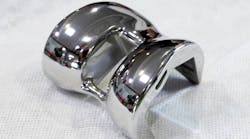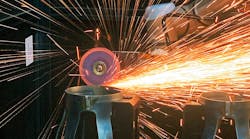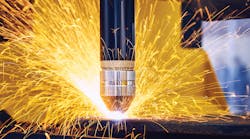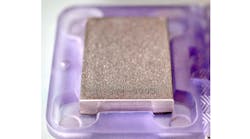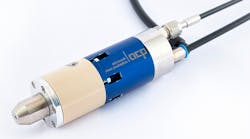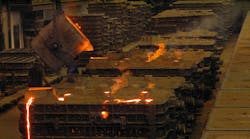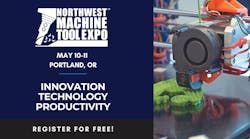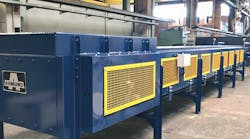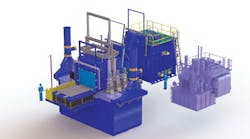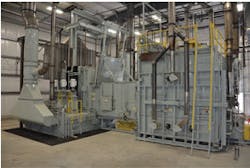In the last decade, the maximum envelope for austempered ductile iron (ADI) components had increased slowly. ADI Treatments in the West Midlands of England has a 5-m3 batch austempering line with a 7.5-metric ton maximum gross load. Jilin ADI in Changchun, China operates a 5.6-m3 batch austempering line with a 4-metric ton gross load capacity.
In recent months, the Applied Process group added an even larger, batch austempering system at its Monster PartsTM Division in Oshkosh, WI. This unit is the largest integral quench batch furnace in the world with a working envelope of 7 m3 and a maximum gross load of 9.1 metric tons. Figure 1 is an illustration of this one-of-a-kind Monster PartsTM furnace in comparison to a standard universal batch quench (UBQ).
This unique Monster furnace shown in Figure 2 has strategically placed natural gas-fired radiant tubes and is designed to meet stringent temperature uniformity requirements. It employs an endothermic gas atmosphere with natural gas additions. The heat and atmosphere are uniformly circulated with the aid of four alloy fans within the furnace. This endo-type atmosphere is less costly to operate and more stable than nitrogen-methanol systems. In addition, it prevents decarburization that comes with either air or nitrogen-only atmosphere systems.
A special, direct gear-drive handling system was developed for this furnace. It allows for the smooth acceleration and deceleration of the load, quickly and without the rough, jerking motions that can plague conventional transfer systems. Such motions can damage components when they are in the soft, red hot state.
UBQA furnaces are known for good quench speed and uniformity. Their unique quench tank and housing design, coupled with proprietary agitation and water additions, result in a quench severity that exceeds that of a typical salt quench system. The oversize quench system specified for the Monster furnace will allow for less than an 8.3°C (15°F) temperature rise for a maximum design gross load. The operating temperature range for this quench system is 182 – 399°C (360-725°F).
Nearly 100% salt reclamation using minimal energy is realized from the aforementioned quench system. Because an atmosphere–to-salt system is employed, the quench salt is not contaminated by drag-out of high temperature austenitizing salt, as is typical of salt-to-salt processes. The salt-rich water from the primary wash can easily be rectified and filtered, and then reclaimed making it a very energy efficient or green technology.
These added capabilities will not only increase productivity on current ADI components, they will make it possible for designers to consider ADI as an alternative to very large steel castings, forgings, weldments, and assemblies. There are opportunities for such large ADI components in railroad, mining, construction, gearbox, and manufacturing machining. Complete heavy axles, large compound gearbox carriers, gears and structural components for large stationary and mobile equipment, and even architectural applications, all may benefit from cost-effective ADI conversions. Finally, this equipment is not limited to ADI as it will be capable of neutral hardening iron and steel components along with carburizing and carbo-austemperingTM steel components.
This heat-treating line is housed in a purpose-build, 1,400 sq. meters (15,000 sq. ft.) facility in Oshkosh, WI.
For more information, visit www.appliedprocess.com/monsterpartshome
